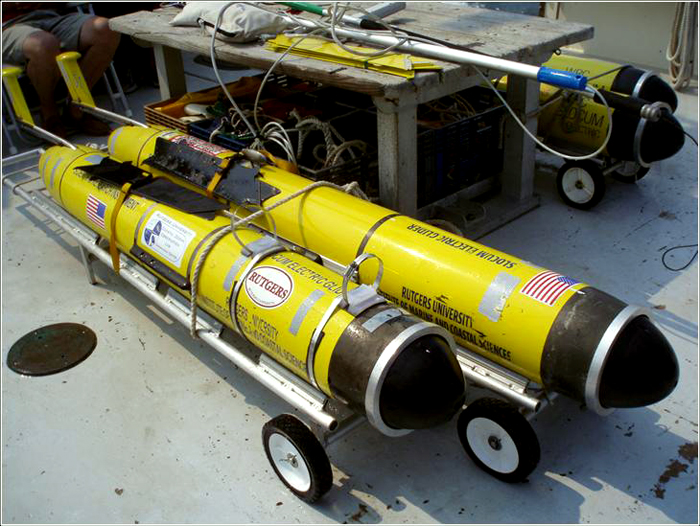
Photo Credit: Coastal Ocean Observation Lab Web site |
A stretched version of the Slocum glider is on the right. The longer robot can carry more batteries, which allow it to cover a greater range during deployments, or additional science instruments. The modular design allows scientists to swap sensors depending on the glider's mission. |
The sensors
The central compartment of each robot contains various sensors, which measure properties such as water temperature and salinity. However, thanks to a modular design that allows the scientists to swap out instruments, and advances in miniaturizing sensors, some of the gliders can do a lot more.
One robot next season already carries optical sensors that can “see” the color of the water, which scientists can use to determine the composition of phytoplankton encountered by the glider. Other sensors can measure fluorescence, which can tell the researchers something about the health and biomass of phytoplankton. Another set of instruments will record acoustics, such as the noises whales make underwater.
“We’re going to build up a fleet of these robots to carry sensors to do the physics, the phytoplankton abundance and health and type, and the acoustics for going after the krill, the whales and anything that makes noises,” Schofield said.
Phytoplankton refers to a conglomeration of free-floating, autotrophic organisms in the ocean that you can’t see individually with the naked eye but appear as a green coloration because of the presence of chlorophyll. (The color may vary depending on the composition of the phytoplankton bloom.)
They are important to local and global ecosystems for a number of reasons. Through photosynthesis, they cycle carbon dioxide out of the atmosphere and account for as much as 50 percent of the oxygen. They also form the basis of the ocean food web, serving as vittles for creatures both large and small — from whales to shrimp-like krill.
The mission
Phytoplankton is but one component of the PAL LTER. Other researchers are interested in ocean microbes, physical ocean properties such as circulation, ice dynamics and various seabirds and mammals. The researchers say sea ice is the linchpin in the system, affecting ocean productivity from the phytoplankton and on up.
For example, sea ice serves as a sort of krill grazing ground. In turn, Adélie penguins rely on krill as their main food staple. But warming temperatures in the region have caused the perennial sea ice to disappear and the annual sea to shrink in duration, causing a ripple through the small food web. (The recent disintegration of a chunk of the Wilkins Ice Shelf may also be due to the absence of sea ice, which buffers ice shelves from the motion of ocean waves.)
But the scientists don’t have all the answers yet. They need more information about the ocean, such as that belt of warm water flushing onto the continental shelf and causing the glaciers to melt more rapidly into the ocean. And what’s all that fresh water doing to ocean mixing and nutrient availability?
Some of the gaps in their knowledge may come from those little torpedo-shaped robots.
“Those gliders will increase by orders of magnitude our ability to cover the regions spatially and temporally and very intensively,” noted Bill Fraser, a PAL LTER research who studies the Adélies and other Antarctic seabirds.
For Schofield, the Slocum glider means that more information will be available to a wider audience, proving the cliché that two heads are better than one for solving a problem.
“Regardless if [scientists] can get ship time, we can get them robot time,” Schofield said. “Having a well-sampled ocean will allow us to answer our questions like we never could before.”
NSF-funded research in this story: Oscar Schofield, Coastal Ocean Observation Lab at Rutgers University; Hugh Ducklow, The Ecosystems Center at the Marine Biological Laboratory; and Bill Fraser, Polar Oceans Research Group.
Back 1 2





